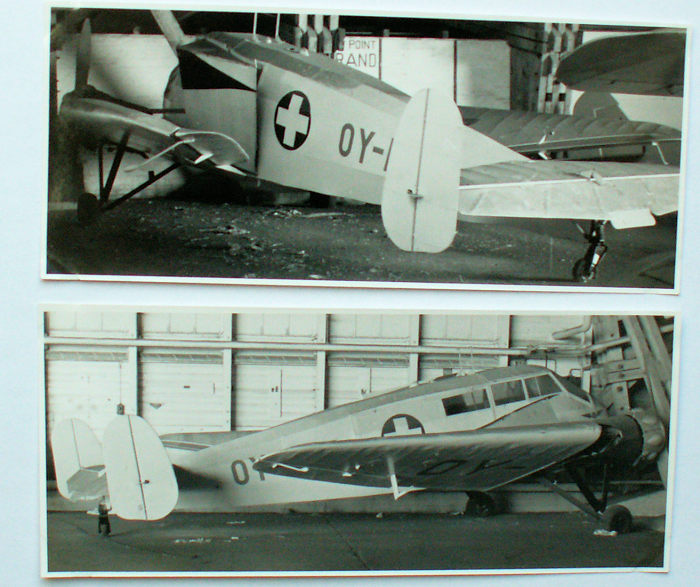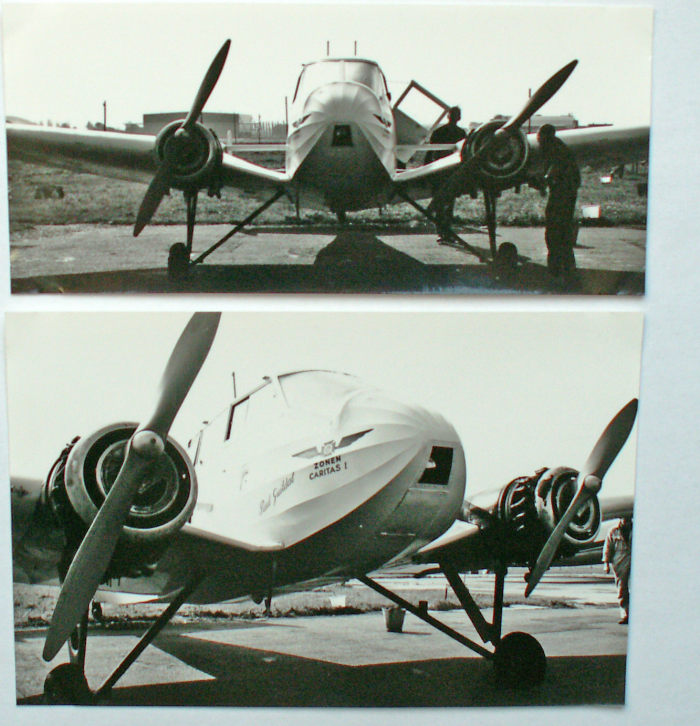The name Monospar refer to a special strong and light cantilever wing with a single main spar. The designations ST-1 and ST-2 were applied for two sets of the Monospar wings, the ST-2 was flight tested on a Fokker F. VII b-3m. The test was successful, and a complete aircraft with a Monospar wing was built, the ST-3. It was built by the Gloster Aircraft Ltd. on behalf of the Monospar Wing company and the ST-3 flew for the first time early in 1931. The flight performance was OK and a new company was formed to build further Monospar Aircraft: the General Aircraft Ltd.
The first aircraft produced by GAL was the ST-4, which was a twin engine fabric covered tubular steel construction. There was accommodation for four persons, and the ST-4 Monospar was powered by a couple of 85 hp. Pobjoy 7 cylinder radials. Six aircraft of this version was built. An improved version was the ST-4 mk. II, this aircraft had a built in landing light under the nose. Twenty four ST-4 mk. II aircraft were built, mostly for private owners.
The ST-6 was a five seater with enlarged cabin and a manually retractable main undercarriage, powered by 90 hp. Pobjoy Niagara radials. The Pobjoy radials do not have the propellers placed in the center as normally by radials. The propeller is placed in the top of the engine. The advantage of this position is that the propeller tips are well cleared off the ground, a good thing for take offs and landings on unprepared fields. Only two ST-6 were built, however, a third aircraft was converted from an ST-4 mk. II.
The next Monospar version was the ST-10 with a redesigned fuselage and taller cabin, more pointed nose and restyled fin and rudder. Only two were built, and one of these aircraft (G-ACTS) won the King’s Cup air race in July 1934 averaging 216 km/h.
The ST-11 was similar to the ST-10, except for a manually retractable main undercarriage as the ST-6. Only two planes were built and both were delivered for airline service in Australia. The ST-12 was powered by two 130 hp. Gipsy Major in line engines, which offered improved performance in spite of a higher gross weight. Newark Air Museum is restoring a Monospar of this version, VH-UHT. In 1935, a single ST-18  Croydon was built. This was an enlarged version powered by two Pratt & Whitney 450 hp Wasp radials and with accommodation for ten passengers and a cruising speed of 280 km/h. This aircraft was lost in October 1936 at the Great Barrier Reef on its way from Australia to England.
Croydon was built. This was an enlarged version powered by two Pratt & Whitney 450 hp Wasp radials and with accommodation for ten passengers and a cruising speed of 280 km/h. This aircraft was lost in October 1936 at the Great Barrier Reef on its way from Australia to England.
The final Monospar variant was the ST-25, which in fact was a development of the ST-10 with 90 hp Pobjoy Niagara II engines. The initial five-seat version was called the “Jubilee,” and entered service with some British airlines. Another version was the “De Luxe”, with four seats, 95 hp Niagara III engines and enlarged fin. Only two ”De luxe” Monospars were built. The second of these was converted to an air ambulance for the British Red Cross. The first “De Luxe” was converted to a “Universal” with twin fin and rudder tail assembly to improve stability with one engine shut down. Besides the outer wing panels could be folded backwards reducing the span to only 4.55 m. This was a practical measure, reducing the required space in a hangar. Twenty six “Universals” were built and several went into airline service in Canada, UK and Australia. In 1940 twenty civil registered Monospars of different versions were impressed for wartime service with the RAF.
The single Danish registered Monospar was a ST-25 Universal ambulance. The construction number was 95 and it was built in 1937. It flew for the first time 6-6-1937 at London Air Park piloted by Hollis Williams. The British registration was G-AEYF. Later the aircraft was used as a demonstrator aircraft in Budapest, Hungaria. 8-3-1939 pilot Williams delivered the aircraft in Kastrup Airport, and the following day the new flying ambulance was presented to the public, still in an all aluminum dope color scheme and carrying the British registration G-AEYF.
By 17-4-1939 the aircraft had been painted in the colors of “Zonens Flyvetjeneste” (Air Service of the Zone Rescue Corps) and got the Danish registration OY-DAZ and the name Caritas 1 (Charity 1). The active years as an ambulance plane lasted until 13-6-1948, when the plane was substituted by a Danish built SAI KZ-IV, which was similar to the Monospar, but of wooden construction, larger with room for two stretchers and two attendants. The last flight of the Monospar took place 18-5-1950, and the total flying time was only 592 hours and 5 minutes, a rather low figure.
In 1959, the Monospar was donated to the Royal Danish Aeroclub, a section of which was working for the establishment of a Danish Aviation Museum. The Monospar was stored in an old German hangar in the  southern part of Kastrup Airport. The wings were folded back and the aircraft only needed a small corner for the storage. The birds in the hangar used the Monospar for their droppings, and in 1966, the Monospar looked more like a camouflaged German night fighter, as the chairman of the Aviation Historical Section put it.
southern part of Kastrup Airport. The wings were folded back and the aircraft only needed a small corner for the storage. The birds in the hangar used the Monospar for their droppings, and in 1966, the Monospar looked more like a camouflaged German night fighter, as the chairman of the Aviation Historical Section put it.
However, on a fine day in the spring 1966, it was the great cleaning day for the Monospar. It was pulled out of the hangar, and outside the wings were folded forward to flying position, and eight members of the Aviation Historical Section armed with brushes, soapy water and buckets did the job. The Monospar looked quite nice when the bird dropping camouflage was gone! The engine cowlings were rusty in some places and needed a renovation. At that time, the OY-DAZ was one of only two surviving Monospars in the world. The other one was in New Zealand with the same owner for fifty years, and still flying.
OY-DAZ was exhibited in the Egeskov Veteranmuseum at Egeskov Castle. One of the magazine buildings was in use for an impressive exhibition of veteran cars, motor bikes and aircraft. In 1980, the Monospar was moved from Egeskov Castle to Østerbrogade kaserne (Army Barracks) in Copenhagen. It was about time for a complete restauration of the aircraft, and in December 1987, this process was finished. In December 1989, the Monospar came to the exhibition building in the airport at Billund. This was the best possible exhibition of the aircraft: Standing on the ground and with the large stretcher door opened, and the stretcher on station in the cabin. The interior color of the cabin appeared to be a medium green, probably “ British interior green”.
